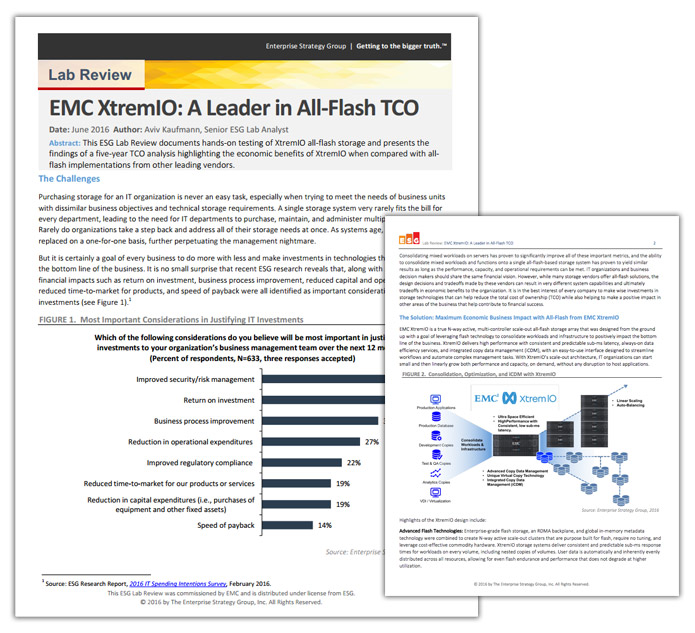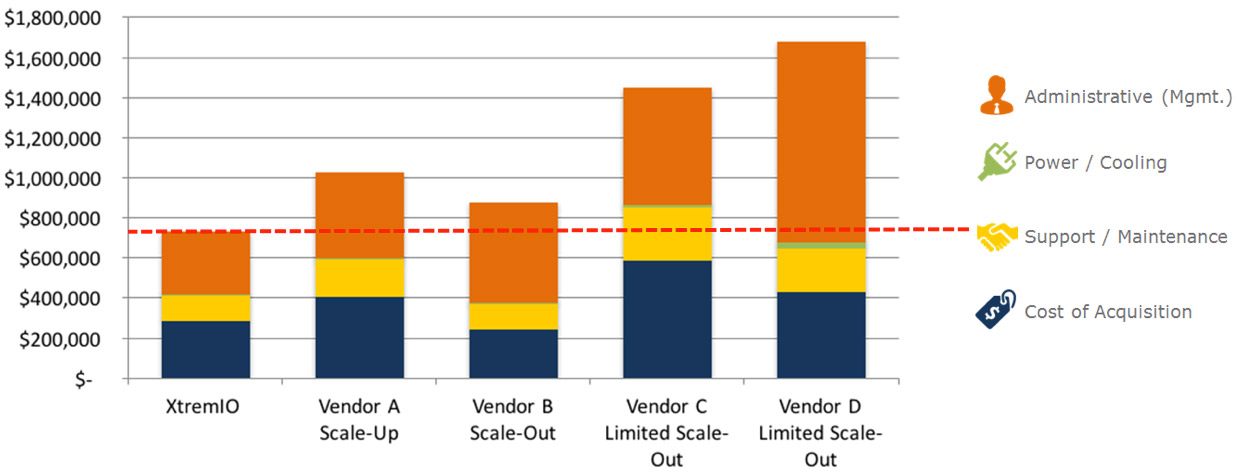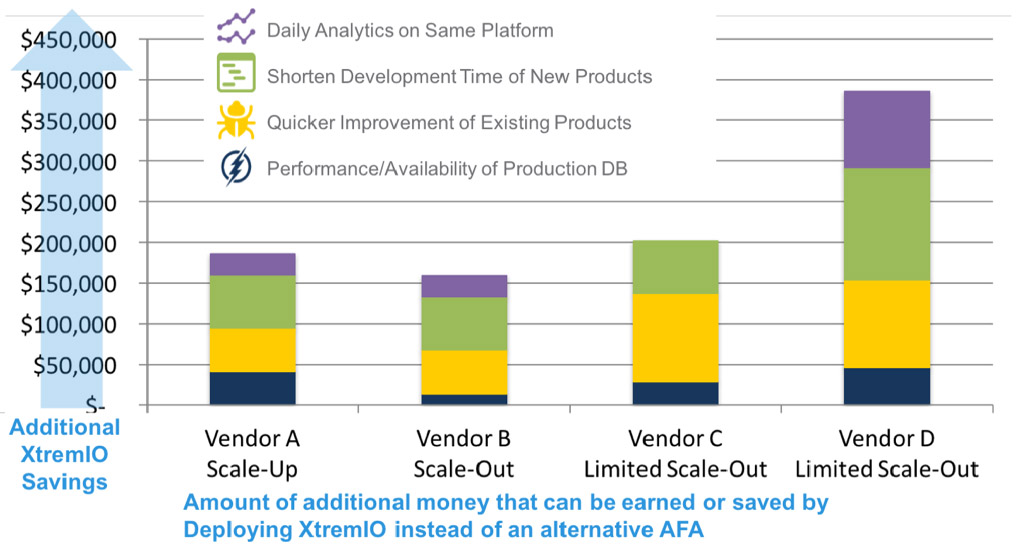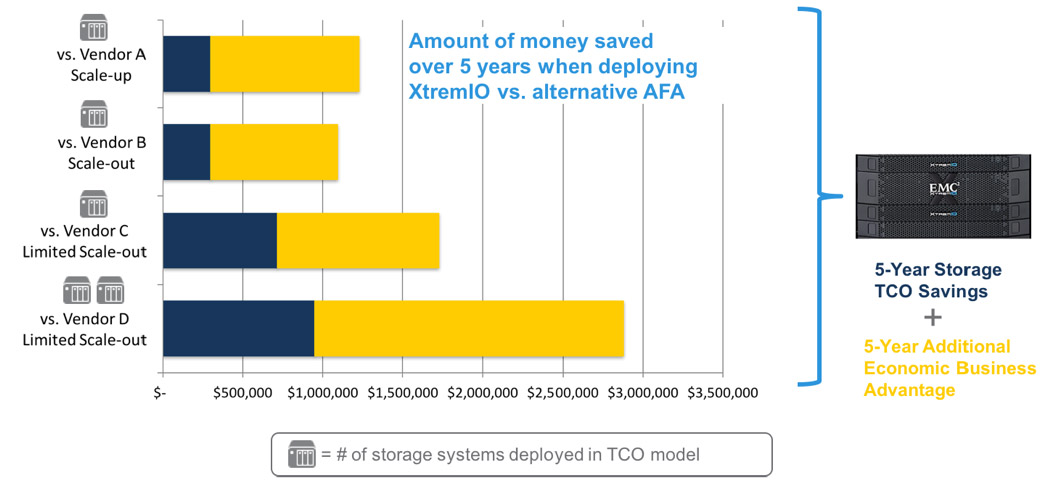This blog was written by Chhandomay Mandal, Solutions Marketing Director for EMC All-Flash Storage

Last year, the ESG analysts studied the 5-year TCO and business impact of consolidating production, development, test/QA, go-live testing as well as VDI environments of a mid-market software development company generating $54M in annual revenue on to a single XtremIO X-Brick.
The analysis contrasted XtremIO benefits against the traditional hybrid storage arrays (dedicated flash and disk-based systems) that the company originally had. The study showed XtremIO offering a 5-year storage TCO savings of $2.8M along with an additional $3.2M in business impact, for a total of $6M advantage.
Often times we get the question: This is exceptionally good, but aren’t modern era all-flash arrays designed to solve the same business challenges? Don’t they all offer same advantages?
Of course we know that this isn’t true. Architecture matters – the design choices made in architecting an all-flash array significantly affect how efficiently it can solve modern data center challenges. We explain the differences between XtremIO and other leading all-flash arrays from different vendors, but customers like to see a quantified result.
To better understand the effects of all-flash design choices translating to business values, we requested ESG to analyze four other market-leading all-flash arrays from different vendors for the same scenario.
ESG has now published their findings in a new TCO study where they used the same modeled development organization and did not change any of the model assumptions from the original report when comparing the TCO of XtremIO to all-flash array offerings from each of these other four vendors.
Although EMC has launched a complete portfolio of flash solutions with VMAX All Flash, Unity and DSSD in 2016, the new report is focused on only XtremIO that was examined in the previous study.
In the new study, ESG referred the other companies as Vendors A through D. Each provided significant TCO and economic business advantages over the traditional storage system that ESG analyzed in 2015. However, ESG found that all of these other all-flash offerings were designed to optimize a few strategic advantages, and did not offer the entire spectrum of benefits that XtremIO did.
For example, Vendor A was designed to be simple to administer, simple to deploy, and space-efficient. However, the active/passive scale-up design, traditional data protection, and redirect-on-write snapshot technology meant more hardware had to be deployed to satisfy the requirements, and the process of dealing with copies of data was simplified, but not optimized.
Vendor B offered a very economical scale-out design using commodity hardware and advanced QoS, but also had to deploy more hardware, and limited redirect-on-write read-only snapshots meant that workarounds had to be employed to manage copies of data.
ESG found that the flash array by Vendor C provided good performance. However, the need to integrate an external storage virtualization solution to provide copy-on-write-based data services greatly reduced its performance capabilities and increased the complexity of the solution.
Finally, Vendor D lacked the management capabilities of the other products and could not provide the predictable performance that is required in a modern data center. The lack of copy data management functionality caused ESG to suggest that it would significantly lengthen the time taken to create, manage and roll forward/back copies for test, development, QA and go-live operations.
The net result?
It was self-evident when ESG compared all five all-flash offerings side by side. As ESG explained, the ability to satisfy the requirements of the organization with less physical hardware generally meant lower costs for acquisition, support and maintenance, and power and cooling. The simplified management and monitoring, along with the zero impact, easy-to-use virtual copy and refresh/restore capabilities of XtremIO, helped to minimize storage-related administrative costs. See the comparison of storage-related TCO across all five all-flash vendors in Figure 1 below.

Figure 1: ESG’s Modeled Five-year Storage TCO for All-Flash Vendors
In addition to offering the lowest storage TCO among the all-flash vendors, ESG also found that XtremIO delivered the largest economic advantage to the modeled software development organization over the five-year period. When compared to most of the other four vendors, the XtremIO solution would be expected to provide more predictable performance and quicker recovery for the production database, resulting in increased customer retention, fewer lost sales, and the ability to benefit from the results of running daily analytics on the same system.
Among the all-flash arrays ESG reviewed, XtremIO is the only one to offer truly advanced copy technology with XtremIO Virtual Copies (XVC) and integrated Copy Data Management (iCDM). These greatly simplify and accelerate the job of providing copies of data for test, development, QA, and go-live testing with little to no impact to the production database. ESG found that the abilities to quickly roll-forward and roll-back changes to these copies result in shorter development cycles for new products and quicker patching and enhancements to existing product lines. This faster time to product revenue streams and increased customer retention for existing products help further justify an investment in XtremIO.
Figure 2 below shows ESG’s findings of the additional economic impact that the modeled organization would be expected to realize by deploying an XtremIO solution rather than any of the four other vendor’s all-flash solutions over this 5-year modeled timeframe.

Figure 2: Additional Economic Benefits Expected from the XtremIO Deployment over Other AFAs
Combing the storage TCO benefits and additional business impact, ESG reveals that the modeled organization could expect to realize approximately $1-3 million more over the 5-year period by deploying XtremIO rather than any of the other four all-flash arrays, as shown in Figure 3 below.

Figure 3: Expected TCO Savings and Economic Benefits Gained by Deploying XtremIO vs. Other AFAs
Get the XtremIO vs. other all-flash arrays TCO study here for the thorough analysis conducted by ESG. Enjoy!
